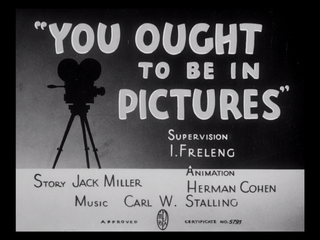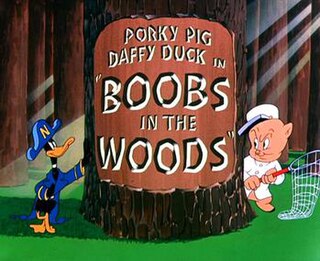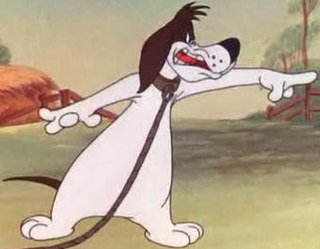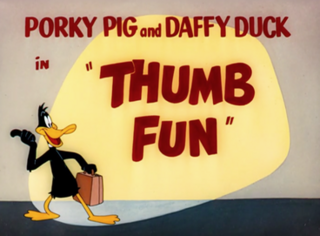
Looney Tunes is an American animated franchise produced and distributed by Warner Bros. It began as a series of short films that originally ran from 1930 to 1969, concurrently with its partner series Merrie Melodies, during the golden age of American animation. Following a revival in the late 1970s, new shorts were released as recently as 2014. The two series introduced a large cast of characters, including Bugs Bunny, Daffy Duck, and Porky Pig. The term Looney Tunes has since been expanded to also refer to the characters themselves.

Daffy Duck is a fictional character created by animators Tex Avery and Bob Clampett for Leon Schlesinger Productions. Styled as an anthropomorphic black duck, he has appeared in cartoon series such as Looney Tunes and Merrie Melodies, in which he is usually depicted as a foil for either Bugs Bunny, Porky Pig or Speedy Gonzales. He was one of the first of the new "screwball" characters that emerged in the late 1930s to replace traditional everyman characters who were more popular earlier in the decade, such as Mickey Mouse, Porky Pig, and Popeye.
Warner Bros. Cartoons, Inc. was an American animation studio, serving as the in-house animation division of Warner Bros. during the Golden Age of American animation. One of the most successful animation studios in American media history, it was primarily responsible for the Looney Tunes and Merrie Melodies series of animated short films. The characters featured in these cartoons, including Bugs Bunny, Daffy Duck, and Porky Pig, are among the most famous and recognizable characters in the world. Many of the creative staff members at the studio, including directors and animators such as Chuck Jones, Friz Freleng, Robert McKimson, Tex Avery, Robert Clampett, Arthur Davis, and Frank Tashlin, are considered major figures in the art and history of traditional animation.

You Ought to Be in Pictures is a 1940 Warner Bros. Looney Tunes short film directed by Friz Freleng. The cartoon was released on May 18, 1940, and stars Porky Pig and Daffy Duck.

Looney Tunes Golden Collection: Volume 1 is a DVD box set that was released by Warner Home Video on October 28, 2003. The first release of the Looney Tunes Golden Collection DVD series, it contains 56 Looney Tunes and Merrie Melodies cartoons and numerous supplements. The set won the Classic Award at the Parents' Choice Awards.

The Ducksters is a 1950 Warner Bros. Looney Tunes theatrical cartoon short, directed by Chuck Jones and written by Michael Maltese. The cartoon was released on September 2, 1950, and stars Daffy Duck and Porky Pig. The title is a pun on the 1947 film The Hucksters.

Daffy Duck Slept Here is a 1948 Warner Bros. Merrie Melodies cartoon, directed by Robert McKimson. The cartoon was released on March 6, 1948, and stars Porky Pig and Daffy Duck.

Boobs in the Woods is a 1950 Warner Bros. Looney Tunes cartoon, directed by Robert McKimson. The cartoon was released on January 28, 1950, and stars Daffy Duck and Porky Pig.
This is a list of all cartoons featuring Porky Pig. Directors are listed in parentheses.

Daffy Duck Hunt is a 1949 Warner Bros. Looney Tunes cartoon, directed by Robert McKimson. The cartoon was released on March 26, 1949, and stars Daffy Duck, Porky Pig and the Barnyard Dawg.
Daffy Doodles is a 1946 Warner Bros. Looney Tunes cartoon directed by Bob McKimson. It was released on April 6, 1946, and stars Daffy Duck and Porky Pig.
This is a listing of all the animated shorts released by Warner Bros. under the Looney Tunes and Merrie Melodies banners between 1960 and 1969. A total of 147 shorts were released during the 1960s.
Tease for Two is a 1965 Warner Bros. Looney Tunes directed by Robert McKimson. The short was released on August 28, 1965, and stars Daffy Duck and the Goofy Gophers in their final appearance. The voices were performed by Mel Blanc. The title is a play on the phrase "tea for two."

Barnyard Dawg is a Looney Tunes character. A feisty anthropomorphic basset hound, he is a friend and the archenemy of Foghorn Leghorn. He was created by Robert McKimson, who also created Foghorn, and was voiced by Mel Blanc. Dawg also feuds with other enemies as well like Henery Hawk, Daffy Duck and Sylvester. He appeared in 23 Golden Age–era Warner Bros. shorts.
Mucho Locos is a 1966 Warner Bros. Merrie Melodies cartoon directed by Robert McKimson. The short was released on February 5, 1966, and stars Daffy Duck and Speedy Gonzales.

Thumb Fun is a 1952 Warner Bros. Looney Tunes short directed by Robert McKimson. The cartoon was released on March 1, 1952, and stars Daffy Duck and Porky Pig.
Cracked Quack is a 1952 Warner Bros. Merrie Melodies short directed by Friz Freleng. The cartoon was released on July 5, 1952, and stars Daffy Duck and Porky Pig.










